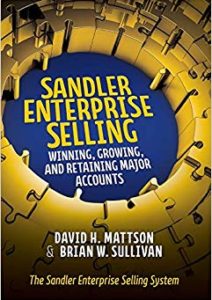As the selling year draws to a close, we’re captivated by Q4 activities focused on closing the year strong in terms of winning business and, hopefully, also delivering as much value as possible to our clients. But as we dwell on individual accounts, we must be careful not to neglect the broader picture.
I love the Clement Stone quote – “You are a product of your environment. So, choose the environment that best develops you toward your objective”. Well said. But what about your environment? Focusing on your pipeline and your clients is certainly important as the year closes but don’t ignore the environment question. What’s changed with my markets in 2022 and where are they headed in 2023? Are they truly, in Clement’s words, “developing you towards your objective”?
I’m not proposing three-day offsites to dive deeply into our markets’ changes. I get it. It’s Q4. Winning business now is critical. Truthfully, though, such focused sessions do have their merit. But I’m suggesting that we all stop and, in the interest of time, conduct concise team brainstorming events that can be just as productive. However you choose to collaborate with your team, by all means do it. Because strategizing about market changes will not only benefit your future planning but could actually create competitive advantage to help close deals right now. Knowledge, as they say, is power. And power creates advantage.
In sales, we our love frameworks – simple and direct guides that take us from murkiness to solid understanding. So, here’s a simple one that charts five critical market areas for your streamlined Q4 brainstorming. Are there other areas? Sure. And of course, there’s overlap.
But in the interest of perfect not being the enemy of good, let’s act now on these:
- Account Base
- Economy
- Service Structure and Deployment
- Market Patterns
- Competition
In selling, it’s all about questions. That’s how we learn. So, consider the most timely questions in each of the five areas. Yours will, of course, be customized to your business but let’s look at some that matter in any model.
Starting with account base, what about your verticals? If you play in Financial Services, what’s the impact of runaway inflation and interest rates? What about Healthcare and Big Pharma? What shifts have the long tails of the pandemic caused? What about the public sector and increases in government funding to serve the greater good? How about traditional retail? Has ubiquitous online ordering hammered in the final nail in the coffin? And what about commercial real estate and the vast future uncertainty it faces?
How about the economy? Seasonality may not have impacted your business before but what about now? With temperature impacts on viruses and variants, how will the healthcare economy transition regarding cold versus warm weather seasons? What about SMB accounts with small business grants and the resulting pains and opportunities? With government decrees worldwide increasingly impacting local economies, consider the economic limitations on the food service industry and its depressed ecosystem of suppliers. And how will future government decisions about unemployment benefits affect your clients’ workforces and customers?
Regarding service structure and deployment, how effectively positioned are you for the virtual world? It’s no longer just a symptom of COVID. It’s here to stay. How does it affect your business model? Can your organization deliver remotely with the same levels of quality as in the past? And while you may yearn to return to in-person selling, research shows your buyers feel differently. How about your team selling assets – your SME’s? Involving them in key sales calls and pursuits without travel and expense is the new agility. And what of the impact of virtual alliance, channel and delivery partnering and the streamlining of contract vehicles? How about your delivery assets – products, services and people? Can they be difference-making advantages for you in winning deals?
And market patterns. How have continually changing demographics impacted your clients and prospects? Residential movement out of city centers will dictate change for your accounts. From real estate to residential construction to transportation – they’re all touched. What about the media, advertising and of course, social platforms? The impact of streaming services and shifting cultural and political patterns – what changes must you act on? And what about your industries’ thought leaders who guide markets? In case you hadn’t noticed, their names have changed.
To wrap up, we consider our competition and think of the old Indian saying, “In the dark of the night, every cat’s a leopard”. Indeed. And as you ponder, know that many of your competitive leopards’ spots have changed significantly. If you don’t know your current adversaries versus their old selves, you’ll pay the price. You’ll lose deals and you’ll lose clients. Competitive propositions, people, partnerships and pricing. Know all the changes.
So assemble your teams – the people truly invested in understanding the changes that impact your markets, your clients and your business. The people who care and can make a difference in executing on the actions from your brainstorming. Ask the questions. Then face the change, embrace the change and make the change. I’ll close with another amazing quote. This one from Warren Bennis which captures the importance of our task at hand – “In life, change is inevitable. In business, change is vital”.













Comments